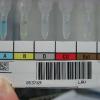Dansket
Members - Bounced Email
-
Joined
-
Last visited
-
Country
United States
Everything posted by Dansket
-
Patient Re-types
I agree with Scott, there is no difference retesting a specimen or specimens from a single venipuncture. The rationale for retyping is based on the premise that your current system has so many 'potential points of failure' that retesting the same specimen or specimens from the same venipuncture may detect errors in specimen identification and/or specimen testing at the workbench. Plus, CAP and AABB allow this to comply with their electronic crossmatch requirements! The gold standard is to perform a second ABO typing on a blood sample collected from a venipuncture done after a second visit to the patient's bedside. This will detect errors in specimen collection and patient identification committed at the bedside. I am a strong proponent of automated testing done on a barcode blood sample because it eliminates so many of the 'potential points of failure' associated with manual testing systems. We don't retest blood samples (re-typing), we obtain a new blood sample from a second venipuncture.
-
Patient Re-types
I don't like the term 're-type', our term is 'ABO confirmation'. We do electronic crossmatch, but follow the algorithm below for all Type and Screens, whether or not patient qualify for electronic crossmatch. Our specimen label includes patient history of ABO/Rh and antibody identification. If no ABO/Rh printed on label, we test the uncentrifuged blood sample with anti-A,B. The anti-A,B test result is entered, saved and filed in Meditech on the Type and Screen blood sample. If the anti-A,B test is agglutinated, the test CONFIRM (red cell typing only) is automatically ordered on a new blood sample that requires a second venipuncture (regardless if patient is in Surgery, Trauma, ER, and Outpatient). If the anti-A,B test is not agglutinated, the test CONFIRMO is automatically ordered on the same blood sample and serves as the second blood type for patients without a history of ABO type. We are not AABB so we don't require red cell and plasma typing.
-
RHIG evaluation using Rh or fetal cell detection methods
We don't. Since immunohematology is not an exact science, one could make a case for putting some sort of disclaimer on every test result we produce.
- To R/O or not to R/O
- DAT instead of auto control?
- DAT instead of auto control?
- ICD-10
- Potentiator QC
- To R/O or not to R/O
-
Antibody ID Flowchart Panel
See the current AABB Technical Manual.
-
can we use hemolysis sample to prepare blood units ?
Do you use EDTA blood samples? We use EDTA blood samples and Anti-IgG gel cards. We don't reject hemolyzed blood samples unless black text on white paper cannot be read through the hemolyzed plasma.
- Meditech 5.67-Where to begin?
-
Blood product issue time
FDA, CAP, AABB are all minimum requirements. Your policy can exceed FDA minimum requirements. I have always used the 'issue' time as the start of the 4 hour clock for units not issued in a cooler.
-
Blood product issue time
Ditto!
-
testing cord bloods
Discontinued routine washing of cord blood cells for standard tube testing decades ago. Routine washing assumes all cord blood samples are contaminated to the extent that false-positive results would be obtained without washing. In the absence of supporting data, it is a "solution looking for a problem".
-
Blood bank Samples
4mL EDTA, 12x75mm Used BioHit automated pipettor (go through plasma to aspirate rbcs after dispensing plasma into antibody screen and reverse grouping, xmatching) Packed RBCs Yes
-
Second ABO/Rh sample
CAP does not specify how to perform second ABO. Both CAP and AABB do specify that only the ABO has to be done, Rh is irrelevant for the purposes of electronic crossmatch criteria.
-
Everything Saline!
Automated testing eliminates all these issues.
-
Rosette testing
Never have used coverslip
-
? Baby need c neg blood
Using DAT results as a criteria to determine/influence the selection of blood for neonatal transfusion is new to me. Would you withhold antigen-negative blood for neonatal transfusion for any newborn with a negative DAT regardless of the results of the mother's antibody screen or antibody history?
-
? Baby need c neg blood
I think you-all missed the point of gagpinks' posting. It was an hypothetical question, "Would you provide little-c negative rbcs or rbcs untested for little-c to this infant if transfusion was required on day 7?"
-
? Baby need c neg blood
I would provide little-c negative blood for neonatal transfusion. Don't understand why DAT status would be reason to deny or provide antigen-negative blood for transfusion.
-
Blood Bank Computer Software (this one? that one? no one?)
If it doesn't have FDA 510K for computer crossmatch, forget it!
-
Polyspecific
I dealt with this issue by doing DAT's on adults (upon physician request) with reporting separate results for anti-IgG and anti-C3d antisera so I didn't have to purchase the polyspecific reagent.
- Use of LipoClear on BBK blood samples

